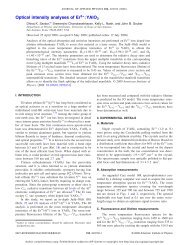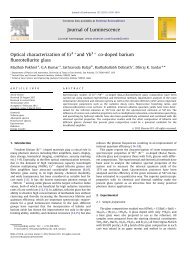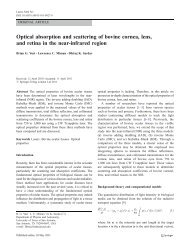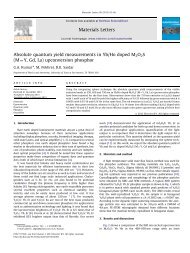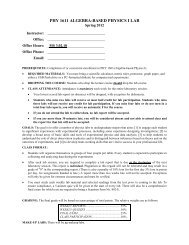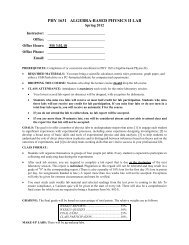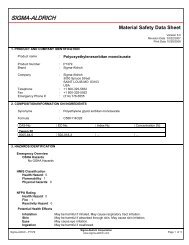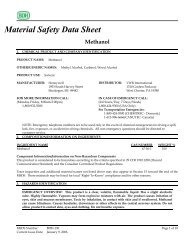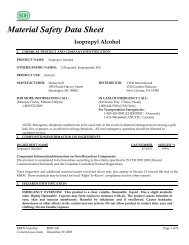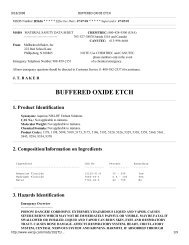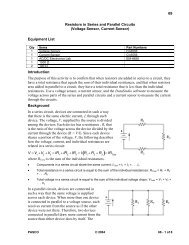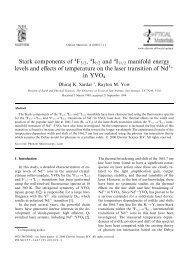Titanium pellets
Titanium pellets
Titanium pellets
Create successful ePaper yourself
Turn your PDF publications into a flip-book with our unique Google optimized e-Paper software.
CERAC Online Catalog Search http://asp.cerac.com/CatalogNet/default.aspx?p=msdsFi...<br />
Use process enclosures, local exhaust ventilation, or other engineering controls to control airborne levels.<br />
Powders under 74 microns are flammable.<br />
WORK/HYGIENIC/MAINTENANCE PRACTICES<br />
Implement engineering and work practice controls to reduce and maintain concentration of exposure at low<br />
levels. Use good housekeeping and sanitation practices. Do not use tobacco or food in work area. Wash<br />
thoroughly before eating and smoking. Do not blow dust off clothing or skin with compressed air.<br />
SECTION 9. PHYSICAL AND CHEMICAL PROPERTIES<br />
<strong>Titanium</strong> metal, powder and pieces (>75 microns)<br />
PHYSICAL STATES: [ ] Gas [ ] Liquid [ X ] Solid<br />
MELTING POINT: 1650.00 C (3002.0 F) - 1670.00 C (3038.0 F)<br />
BOILING POINT: 3287.00 C (5948.6 F)<br />
AUTOIGNITION PT: 1200.00 C (2192.0 F)<br />
FLASH PT: N.A.<br />
EXPLOSIVE LIMITS: LEL: NA UEL: NA<br />
SPECIFIC GRAVITY (WATER = 1): 4.5 at 20.0 C (68.0 F)<br />
VAPOR PRESSURE (VS. AIR OR<br />
MM HG):<br />
0 at 20.0 C (68.0 F)<br />
VAPOR DENSITY (VS. AIR = 1): No data.<br />
EVAPORATION RATE (VS BUTYL<br />
ACETATE=1):<br />
No data.<br />
SOLUBILITY IN WATER:<br />
SOLUBILITY NOTES<br />
decomposes steam at 700-800C<br />
insoluble<br />
PERCENT VOLATILE: N.A.<br />
CORROSION RATE: No data.<br />
FORMULA: Ti<br />
MOLECULAR WEIGHT: 47.88<br />
PH:<br />
APPEARANCE AND ODOR<br />
No data.<br />
Dark gray powder or silver-gray pieces, no odor.<br />
SECTION 10. STABILITY AND REACTIVITY<br />
<strong>Titanium</strong> metal, powder and pieces (>75 microns)<br />
STABILITY: Unstable [ ] Stable [ X ]<br />
CONDITIONS TO AVOID - INSTABILITY<br />
Dispersion in air<br />
INCOMPATIBILITY - MATERIALS TO AVOID<br />
TITANIUM: Air, BrF3, CuO, PbO, (Ni + KClO3), metaloxy salts, halocarbons, halogens. CO2, metal carbonates,<br />
Al, AgF, O2 nitryl fluoride, HNO3, KClO3, KNO3, KMnO4, steam (>700C), trichloroethylene, trichlorotrifluoroethane,<br />
oxygen, carbon black, carbon dioxide and nitrogen, sodium chlorate.<br />
Water applied to hot titanium may evolve hydrogen, causing an explosion.<br />
HAZARDOUS DECOMPOSITION OR BYPRODUCTS<br />
4 of 6 10/28/2008 9:17 AM




